Comprehensive Analysis of Al Ain City in UAE: Environmental Project
VerifiedAdded on 2020/04/15
|12
|3403
|55
Project
AI Summary
This project provides a comprehensive analysis of Al Ain City, located in the United Arab Emirates, examining various facets of the city's development and environmental sustainability. The project delves into the administrative structure, land use patterns, and population trends, highlighting the city's growth and transformation. It explores the city's resource flows, including water management and conservation efforts, as well as the impact of tourism and business activities. Furthermore, the project addresses critical environmental management issues, such as pollution, ecological footprints, and the city's response to these challenges. The analysis covers historical data, current strategies, and future plans, offering a holistic view of Al Ain's environmental landscape and sustainable development initiatives. The project also discusses the role of various governmental and municipal bodies in shaping the city's environmental policies and practices.
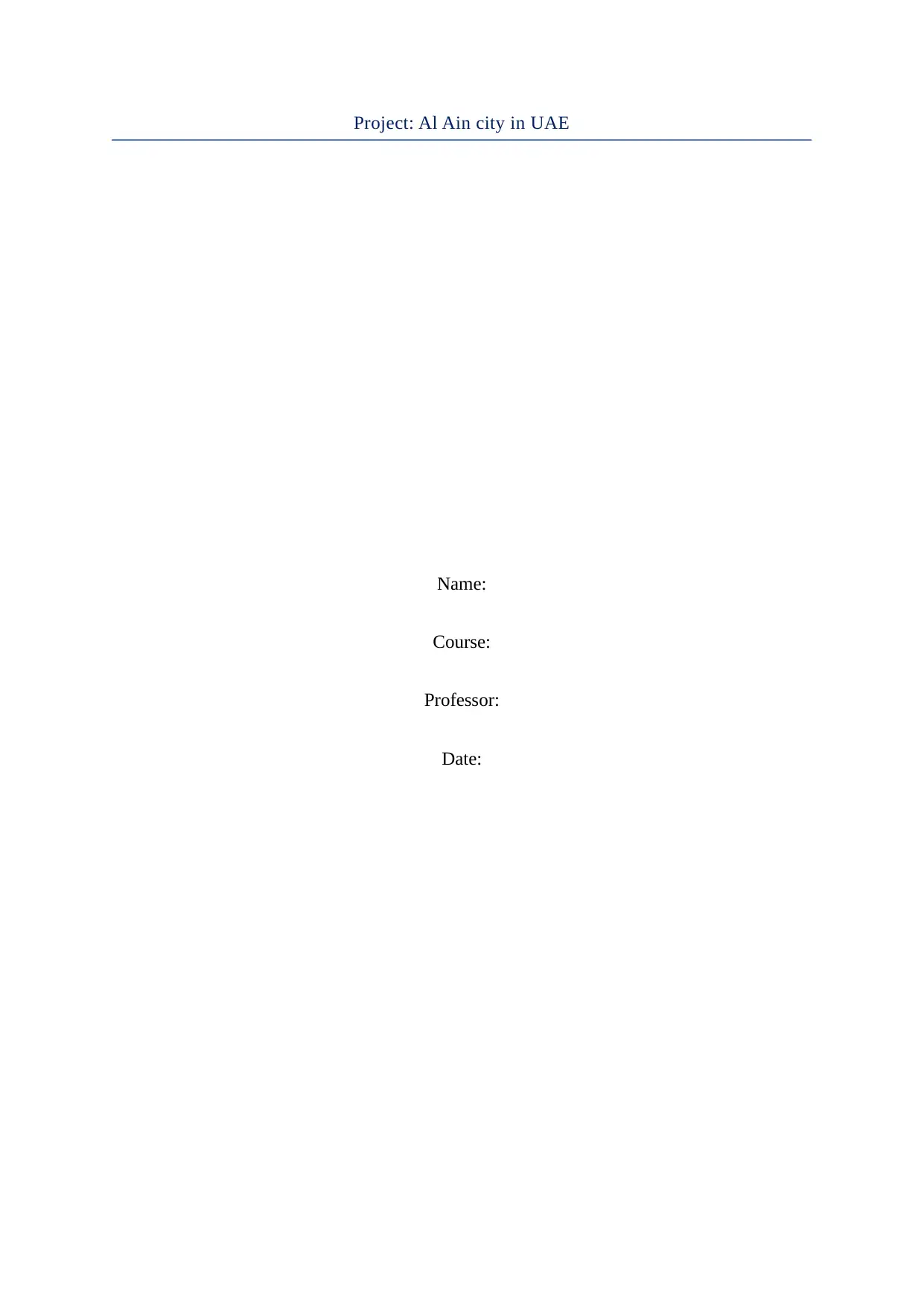
Project: Al Ain city in UAE
Name:
Course:
Professor:
Date:
Name:
Course:
Professor:
Date:
Paraphrase This Document
Need a fresh take? Get an instant paraphrase of this document with our AI Paraphraser
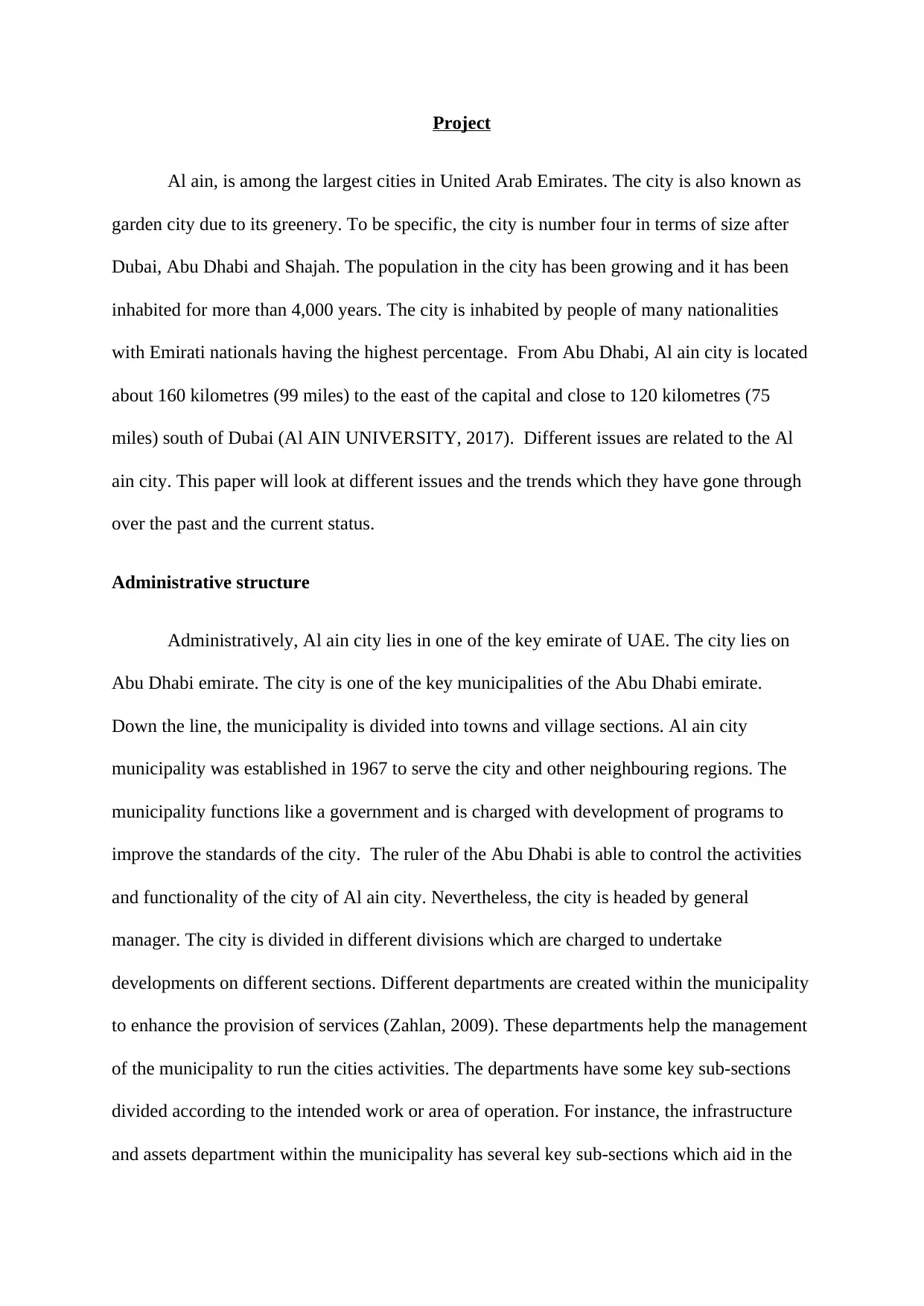
Project
Al ain, is among the largest cities in United Arab Emirates. The city is also known as
garden city due to its greenery. To be specific, the city is number four in terms of size after
Dubai, Abu Dhabi and Shajah. The population in the city has been growing and it has been
inhabited for more than 4,000 years. The city is inhabited by people of many nationalities
with Emirati nationals having the highest percentage. From Abu Dhabi, Al ain city is located
about 160 kilometres (99 miles) to the east of the capital and close to 120 kilometres (75
miles) south of Dubai (Al AIN UNIVERSITY, 2017). Different issues are related to the Al
ain city. This paper will look at different issues and the trends which they have gone through
over the past and the current status.
Administrative structure
Administratively, Al ain city lies in one of the key emirate of UAE. The city lies on
Abu Dhabi emirate. The city is one of the key municipalities of the Abu Dhabi emirate.
Down the line, the municipality is divided into towns and village sections. Al ain city
municipality was established in 1967 to serve the city and other neighbouring regions. The
municipality functions like a government and is charged with development of programs to
improve the standards of the city. The ruler of the Abu Dhabi is able to control the activities
and functionality of the city of Al ain city. Nevertheless, the city is headed by general
manager. The city is divided in different divisions which are charged to undertake
developments on different sections. Different departments are created within the municipality
to enhance the provision of services (Zahlan, 2009). These departments help the management
of the municipality to run the cities activities. The departments have some key sub-sections
divided according to the intended work or area of operation. For instance, the infrastructure
and assets department within the municipality has several key sub-sections which aid in the
Al ain, is among the largest cities in United Arab Emirates. The city is also known as
garden city due to its greenery. To be specific, the city is number four in terms of size after
Dubai, Abu Dhabi and Shajah. The population in the city has been growing and it has been
inhabited for more than 4,000 years. The city is inhabited by people of many nationalities
with Emirati nationals having the highest percentage. From Abu Dhabi, Al ain city is located
about 160 kilometres (99 miles) to the east of the capital and close to 120 kilometres (75
miles) south of Dubai (Al AIN UNIVERSITY, 2017). Different issues are related to the Al
ain city. This paper will look at different issues and the trends which they have gone through
over the past and the current status.
Administrative structure
Administratively, Al ain city lies in one of the key emirate of UAE. The city lies on
Abu Dhabi emirate. The city is one of the key municipalities of the Abu Dhabi emirate.
Down the line, the municipality is divided into towns and village sections. Al ain city
municipality was established in 1967 to serve the city and other neighbouring regions. The
municipality functions like a government and is charged with development of programs to
improve the standards of the city. The ruler of the Abu Dhabi is able to control the activities
and functionality of the city of Al ain city. Nevertheless, the city is headed by general
manager. The city is divided in different divisions which are charged to undertake
developments on different sections. Different departments are created within the municipality
to enhance the provision of services (Zahlan, 2009). These departments help the management
of the municipality to run the cities activities. The departments have some key sub-sections
divided according to the intended work or area of operation. For instance, the infrastructure
and assets department within the municipality has several key sub-sections which aid in the
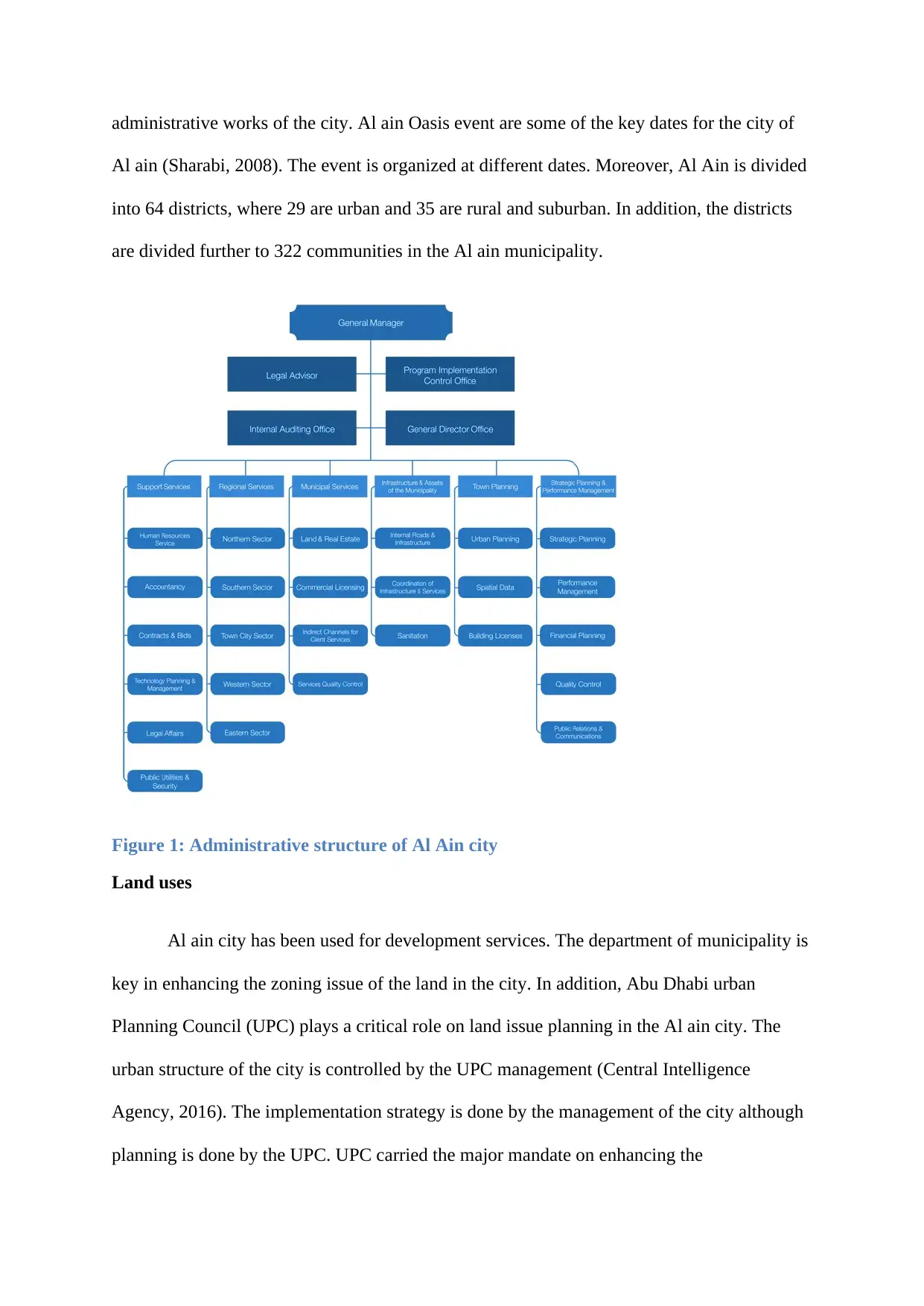
administrative works of the city. Al ain Oasis event are some of the key dates for the city of
Al ain (Sharabi, 2008). The event is organized at different dates. Moreover, Al Ain is divided
into 64 districts, where 29 are urban and 35 are rural and suburban. In addition, the districts
are divided further to 322 communities in the Al ain municipality.
Figure 1: Administrative structure of Al Ain city
Land uses
Al ain city has been used for development services. The department of municipality is
key in enhancing the zoning issue of the land in the city. In addition, Abu Dhabi urban
Planning Council (UPC) plays a critical role on land issue planning in the Al ain city. The
urban structure of the city is controlled by the UPC management (Central Intelligence
Agency, 2016). The implementation strategy is done by the management of the city although
planning is done by the UPC. UPC carried the major mandate on enhancing the
Al ain (Sharabi, 2008). The event is organized at different dates. Moreover, Al Ain is divided
into 64 districts, where 29 are urban and 35 are rural and suburban. In addition, the districts
are divided further to 322 communities in the Al ain municipality.
Figure 1: Administrative structure of Al Ain city
Land uses
Al ain city has been used for development services. The department of municipality is
key in enhancing the zoning issue of the land in the city. In addition, Abu Dhabi urban
Planning Council (UPC) plays a critical role on land issue planning in the Al ain city. The
urban structure of the city is controlled by the UPC management (Central Intelligence
Agency, 2016). The implementation strategy is done by the management of the city although
planning is done by the UPC. UPC carried the major mandate on enhancing the
⊘ This is a preview!⊘
Do you want full access?
Subscribe today to unlock all pages.

Trusted by 1+ million students worldwide
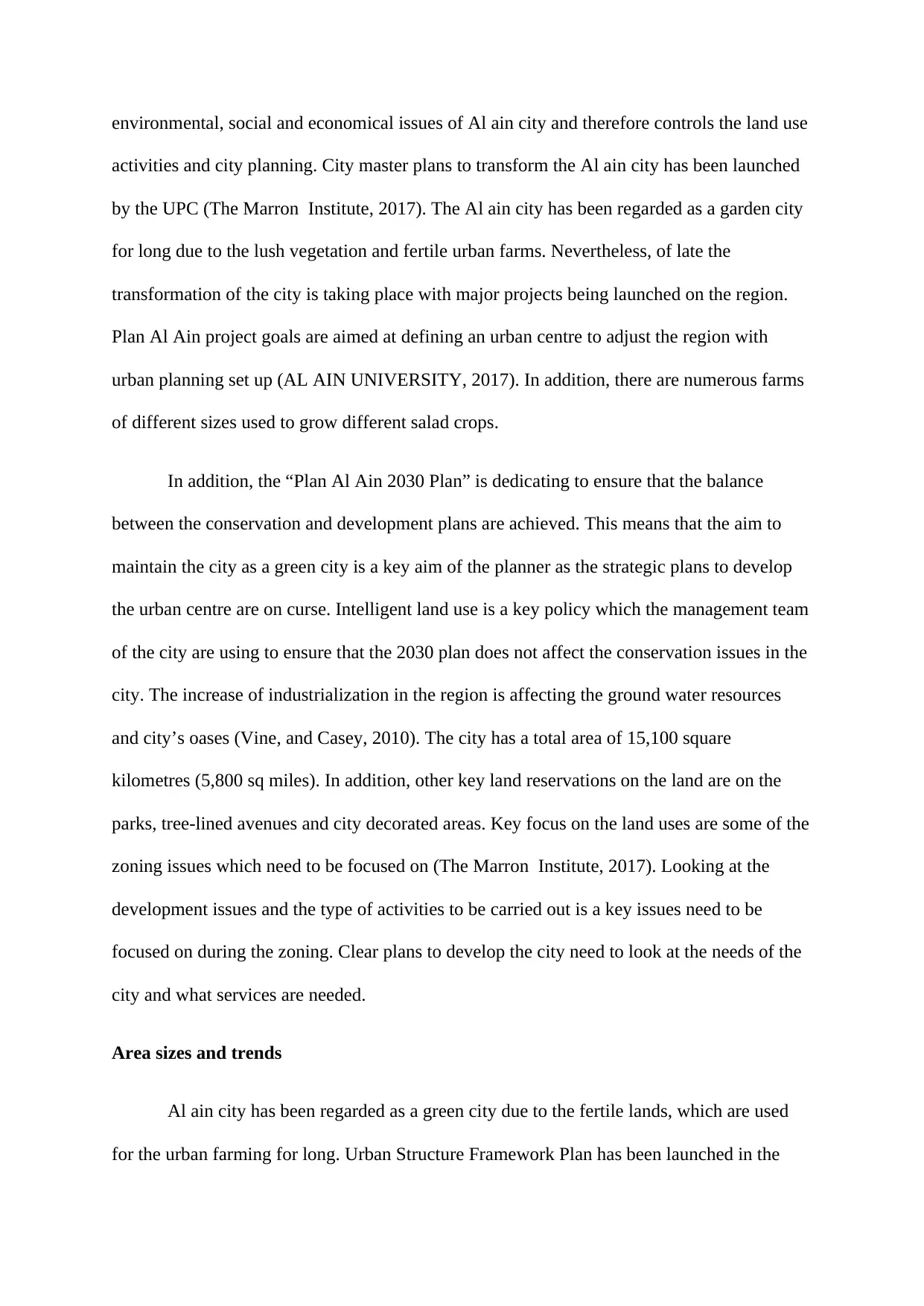
environmental, social and economical issues of Al ain city and therefore controls the land use
activities and city planning. City master plans to transform the Al ain city has been launched
by the UPC (The Marron Institute, 2017). The Al ain city has been regarded as a garden city
for long due to the lush vegetation and fertile urban farms. Nevertheless, of late the
transformation of the city is taking place with major projects being launched on the region.
Plan Al Ain project goals are aimed at defining an urban centre to adjust the region with
urban planning set up (AL AIN UNIVERSITY, 2017). In addition, there are numerous farms
of different sizes used to grow different salad crops.
In addition, the “Plan Al Ain 2030 Plan” is dedicating to ensure that the balance
between the conservation and development plans are achieved. This means that the aim to
maintain the city as a green city is a key aim of the planner as the strategic plans to develop
the urban centre are on curse. Intelligent land use is a key policy which the management team
of the city are using to ensure that the 2030 plan does not affect the conservation issues in the
city. The increase of industrialization in the region is affecting the ground water resources
and city’s oases (Vine, and Casey, 2010). The city has a total area of 15,100 square
kilometres (5,800 sq miles). In addition, other key land reservations on the land are on the
parks, tree-lined avenues and city decorated areas. Key focus on the land uses are some of the
zoning issues which need to be focused on (The Marron Institute, 2017). Looking at the
development issues and the type of activities to be carried out is a key issues need to be
focused on during the zoning. Clear plans to develop the city need to look at the needs of the
city and what services are needed.
Area sizes and trends
Al ain city has been regarded as a green city due to the fertile lands, which are used
for the urban farming for long. Urban Structure Framework Plan has been launched in the
activities and city planning. City master plans to transform the Al ain city has been launched
by the UPC (The Marron Institute, 2017). The Al ain city has been regarded as a garden city
for long due to the lush vegetation and fertile urban farms. Nevertheless, of late the
transformation of the city is taking place with major projects being launched on the region.
Plan Al Ain project goals are aimed at defining an urban centre to adjust the region with
urban planning set up (AL AIN UNIVERSITY, 2017). In addition, there are numerous farms
of different sizes used to grow different salad crops.
In addition, the “Plan Al Ain 2030 Plan” is dedicating to ensure that the balance
between the conservation and development plans are achieved. This means that the aim to
maintain the city as a green city is a key aim of the planner as the strategic plans to develop
the urban centre are on curse. Intelligent land use is a key policy which the management team
of the city are using to ensure that the 2030 plan does not affect the conservation issues in the
city. The increase of industrialization in the region is affecting the ground water resources
and city’s oases (Vine, and Casey, 2010). The city has a total area of 15,100 square
kilometres (5,800 sq miles). In addition, other key land reservations on the land are on the
parks, tree-lined avenues and city decorated areas. Key focus on the land uses are some of the
zoning issues which need to be focused on (The Marron Institute, 2017). Looking at the
development issues and the type of activities to be carried out is a key issues need to be
focused on during the zoning. Clear plans to develop the city need to look at the needs of the
city and what services are needed.
Area sizes and trends
Al ain city has been regarded as a green city due to the fertile lands, which are used
for the urban farming for long. Urban Structure Framework Plan has been launched in the
Paraphrase This Document
Need a fresh take? Get an instant paraphrase of this document with our AI Paraphraser
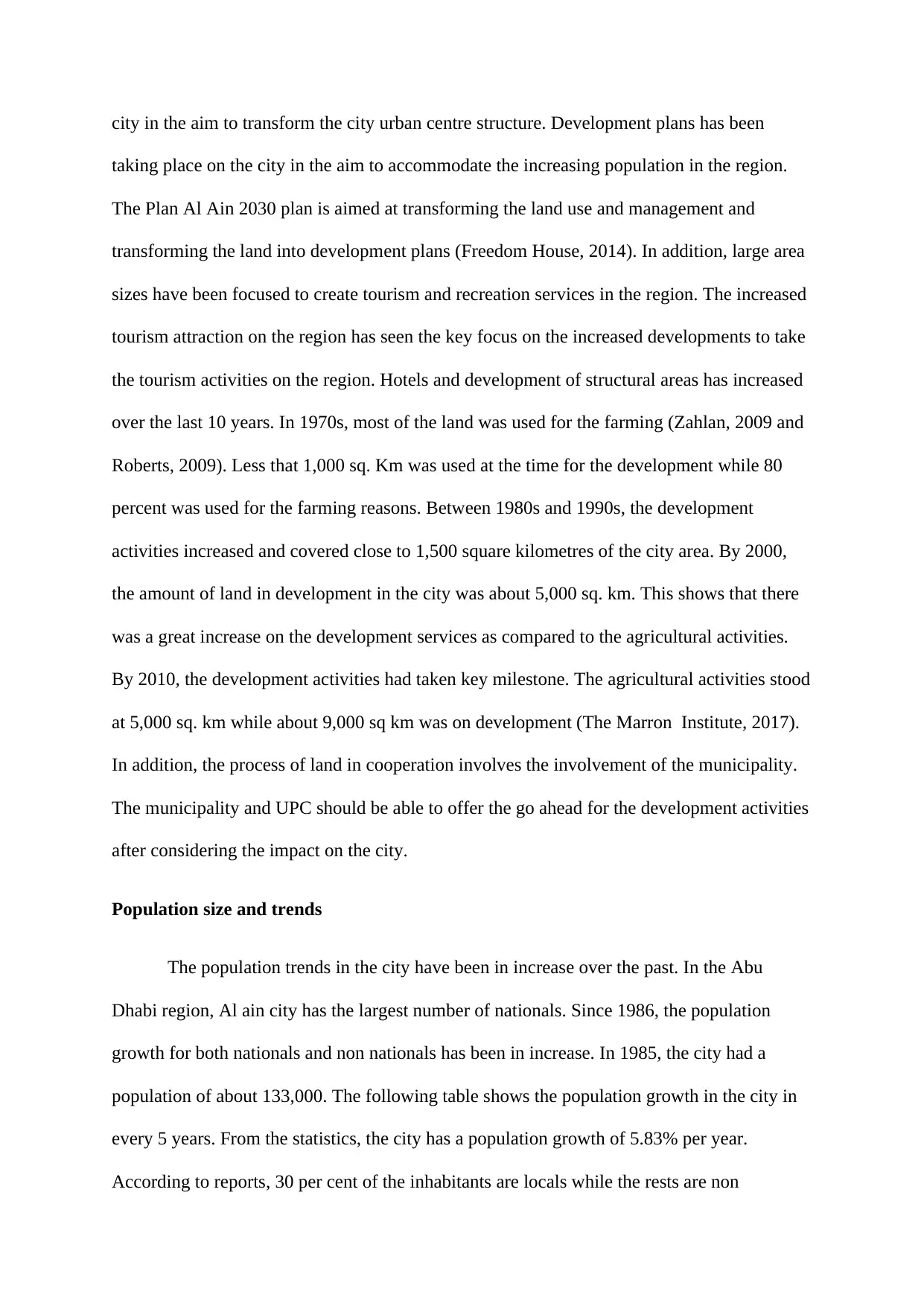
city in the aim to transform the city urban centre structure. Development plans has been
taking place on the city in the aim to accommodate the increasing population in the region.
The Plan Al Ain 2030 plan is aimed at transforming the land use and management and
transforming the land into development plans (Freedom House, 2014). In addition, large area
sizes have been focused to create tourism and recreation services in the region. The increased
tourism attraction on the region has seen the key focus on the increased developments to take
the tourism activities on the region. Hotels and development of structural areas has increased
over the last 10 years. In 1970s, most of the land was used for the farming (Zahlan, 2009 and
Roberts, 2009). Less that 1,000 sq. Km was used at the time for the development while 80
percent was used for the farming reasons. Between 1980s and 1990s, the development
activities increased and covered close to 1,500 square kilometres of the city area. By 2000,
the amount of land in development in the city was about 5,000 sq. km. This shows that there
was a great increase on the development services as compared to the agricultural activities.
By 2010, the development activities had taken key milestone. The agricultural activities stood
at 5,000 sq. km while about 9,000 sq km was on development (The Marron Institute, 2017).
In addition, the process of land in cooperation involves the involvement of the municipality.
The municipality and UPC should be able to offer the go ahead for the development activities
after considering the impact on the city.
Population size and trends
The population trends in the city have been in increase over the past. In the Abu
Dhabi region, Al ain city has the largest number of nationals. Since 1986, the population
growth for both nationals and non nationals has been in increase. In 1985, the city had a
population of about 133,000. The following table shows the population growth in the city in
every 5 years. From the statistics, the city has a population growth of 5.83% per year.
According to reports, 30 per cent of the inhabitants are locals while the rests are non
taking place on the city in the aim to accommodate the increasing population in the region.
The Plan Al Ain 2030 plan is aimed at transforming the land use and management and
transforming the land into development plans (Freedom House, 2014). In addition, large area
sizes have been focused to create tourism and recreation services in the region. The increased
tourism attraction on the region has seen the key focus on the increased developments to take
the tourism activities on the region. Hotels and development of structural areas has increased
over the last 10 years. In 1970s, most of the land was used for the farming (Zahlan, 2009 and
Roberts, 2009). Less that 1,000 sq. Km was used at the time for the development while 80
percent was used for the farming reasons. Between 1980s and 1990s, the development
activities increased and covered close to 1,500 square kilometres of the city area. By 2000,
the amount of land in development in the city was about 5,000 sq. km. This shows that there
was a great increase on the development services as compared to the agricultural activities.
By 2010, the development activities had taken key milestone. The agricultural activities stood
at 5,000 sq. km while about 9,000 sq km was on development (The Marron Institute, 2017).
In addition, the process of land in cooperation involves the involvement of the municipality.
The municipality and UPC should be able to offer the go ahead for the development activities
after considering the impact on the city.
Population size and trends
The population trends in the city have been in increase over the past. In the Abu
Dhabi region, Al ain city has the largest number of nationals. Since 1986, the population
growth for both nationals and non nationals has been in increase. In 1985, the city had a
population of about 133,000. The following table shows the population growth in the city in
every 5 years. From the statistics, the city has a population growth of 5.83% per year.
According to reports, 30 per cent of the inhabitants are locals while the rests are non
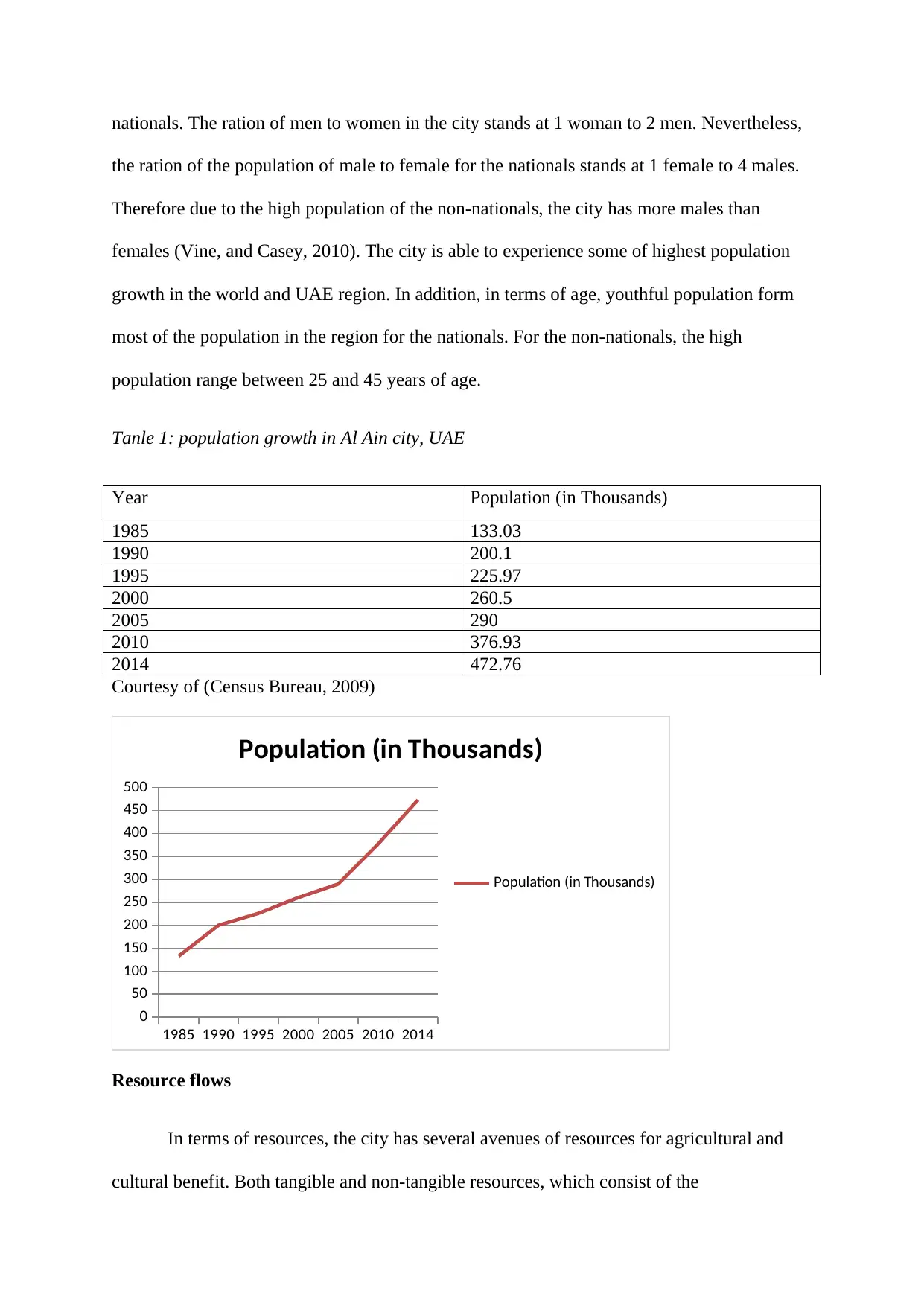
nationals. The ration of men to women in the city stands at 1 woman to 2 men. Nevertheless,
the ration of the population of male to female for the nationals stands at 1 female to 4 males.
Therefore due to the high population of the non-nationals, the city has more males than
females (Vine, and Casey, 2010). The city is able to experience some of highest population
growth in the world and UAE region. In addition, in terms of age, youthful population form
most of the population in the region for the nationals. For the non-nationals, the high
population range between 25 and 45 years of age.
Tanle 1: population growth in Al Ain city, UAE
Year Population (in Thousands)
1985 133.03
1990 200.1
1995 225.97
2000 260.5
2005 290
2010 376.93
2014 472.76
Courtesy of (Census Bureau, 2009)
1985 1990 1995 2000 2005 2010 2014
0
50
100
150
200
250
300
350
400
450
500
Population (in Thousands)
Population (in Thousands)
Resource flows
In terms of resources, the city has several avenues of resources for agricultural and
cultural benefit. Both tangible and non-tangible resources, which consist of the
the ration of the population of male to female for the nationals stands at 1 female to 4 males.
Therefore due to the high population of the non-nationals, the city has more males than
females (Vine, and Casey, 2010). The city is able to experience some of highest population
growth in the world and UAE region. In addition, in terms of age, youthful population form
most of the population in the region for the nationals. For the non-nationals, the high
population range between 25 and 45 years of age.
Tanle 1: population growth in Al Ain city, UAE
Year Population (in Thousands)
1985 133.03
1990 200.1
1995 225.97
2000 260.5
2005 290
2010 376.93
2014 472.76
Courtesy of (Census Bureau, 2009)
1985 1990 1995 2000 2005 2010 2014
0
50
100
150
200
250
300
350
400
450
500
Population (in Thousands)
Population (in Thousands)
Resource flows
In terms of resources, the city has several avenues of resources for agricultural and
cultural benefit. Both tangible and non-tangible resources, which consist of the
⊘ This is a preview!⊘
Do you want full access?
Subscribe today to unlock all pages.

Trusted by 1+ million students worldwide
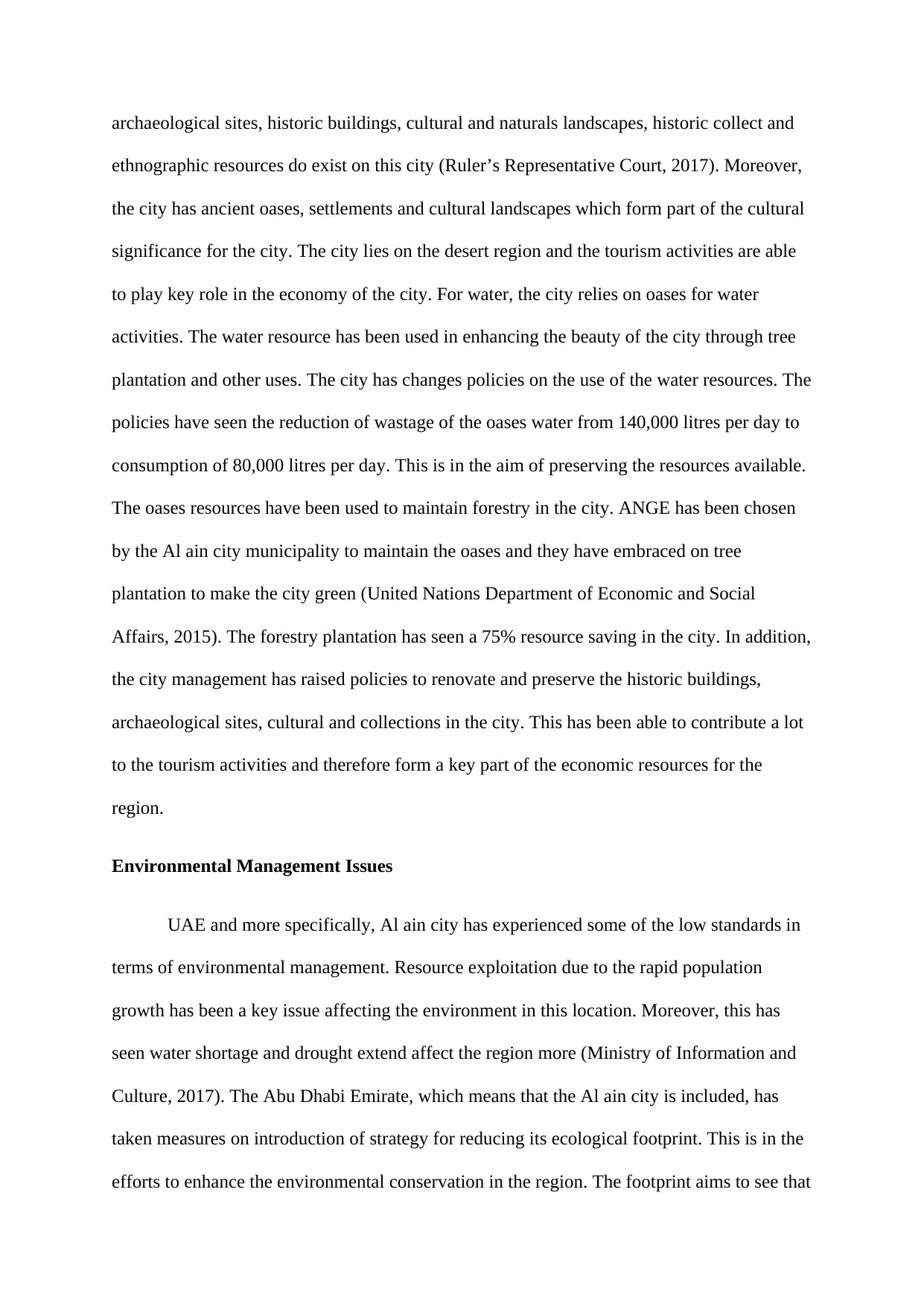
archaeological sites, historic buildings, cultural and naturals landscapes, historic collect and
ethnographic resources do exist on this city (Ruler’s Representative Court, 2017). Moreover,
the city has ancient oases, settlements and cultural landscapes which form part of the cultural
significance for the city. The city lies on the desert region and the tourism activities are able
to play key role in the economy of the city. For water, the city relies on oases for water
activities. The water resource has been used in enhancing the beauty of the city through tree
plantation and other uses. The city has changes policies on the use of the water resources. The
policies have seen the reduction of wastage of the oases water from 140,000 litres per day to
consumption of 80,000 litres per day. This is in the aim of preserving the resources available.
The oases resources have been used to maintain forestry in the city. ANGE has been chosen
by the Al ain city municipality to maintain the oases and they have embraced on tree
plantation to make the city green (United Nations Department of Economic and Social
Affairs, 2015). The forestry plantation has seen a 75% resource saving in the city. In addition,
the city management has raised policies to renovate and preserve the historic buildings,
archaeological sites, cultural and collections in the city. This has been able to contribute a lot
to the tourism activities and therefore form a key part of the economic resources for the
region.
Environmental Management Issues
UAE and more specifically, Al ain city has experienced some of the low standards in
terms of environmental management. Resource exploitation due to the rapid population
growth has been a key issue affecting the environment in this location. Moreover, this has
seen water shortage and drought extend affect the region more (Ministry of Information and
Culture, 2017). The Abu Dhabi Emirate, which means that the Al ain city is included, has
taken measures on introduction of strategy for reducing its ecological footprint. This is in the
efforts to enhance the environmental conservation in the region. The footprint aims to see that
ethnographic resources do exist on this city (Ruler’s Representative Court, 2017). Moreover,
the city has ancient oases, settlements and cultural landscapes which form part of the cultural
significance for the city. The city lies on the desert region and the tourism activities are able
to play key role in the economy of the city. For water, the city relies on oases for water
activities. The water resource has been used in enhancing the beauty of the city through tree
plantation and other uses. The city has changes policies on the use of the water resources. The
policies have seen the reduction of wastage of the oases water from 140,000 litres per day to
consumption of 80,000 litres per day. This is in the aim of preserving the resources available.
The oases resources have been used to maintain forestry in the city. ANGE has been chosen
by the Al ain city municipality to maintain the oases and they have embraced on tree
plantation to make the city green (United Nations Department of Economic and Social
Affairs, 2015). The forestry plantation has seen a 75% resource saving in the city. In addition,
the city management has raised policies to renovate and preserve the historic buildings,
archaeological sites, cultural and collections in the city. This has been able to contribute a lot
to the tourism activities and therefore form a key part of the economic resources for the
region.
Environmental Management Issues
UAE and more specifically, Al ain city has experienced some of the low standards in
terms of environmental management. Resource exploitation due to the rapid population
growth has been a key issue affecting the environment in this location. Moreover, this has
seen water shortage and drought extend affect the region more (Ministry of Information and
Culture, 2017). The Abu Dhabi Emirate, which means that the Al ain city is included, has
taken measures on introduction of strategy for reducing its ecological footprint. This is in the
efforts to enhance the environmental conservation in the region. The footprint aims to see that
Paraphrase This Document
Need a fresh take? Get an instant paraphrase of this document with our AI Paraphraser
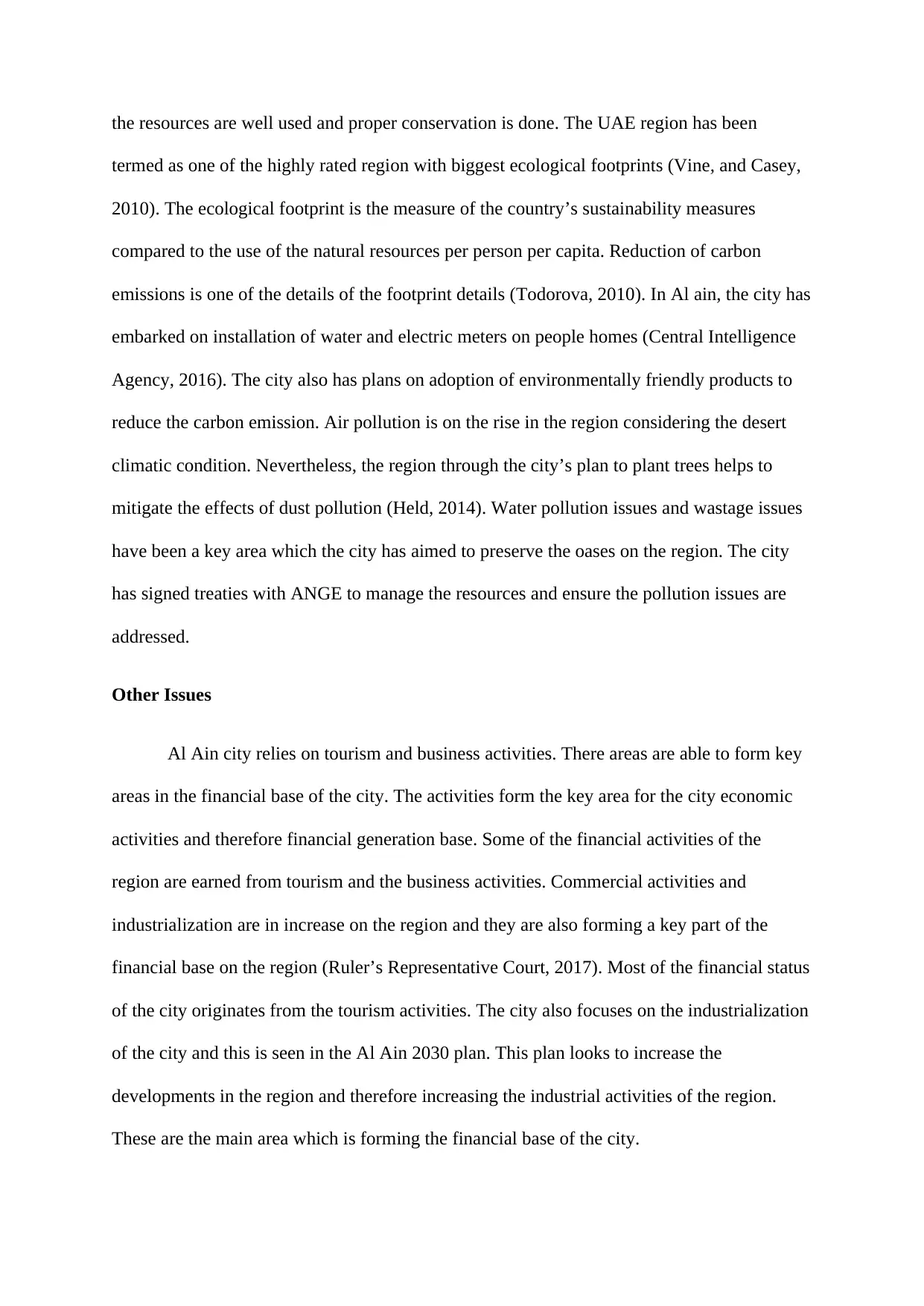
the resources are well used and proper conservation is done. The UAE region has been
termed as one of the highly rated region with biggest ecological footprints (Vine, and Casey,
2010). The ecological footprint is the measure of the country’s sustainability measures
compared to the use of the natural resources per person per capita. Reduction of carbon
emissions is one of the details of the footprint details (Todorova, 2010). In Al ain, the city has
embarked on installation of water and electric meters on people homes (Central Intelligence
Agency, 2016). The city also has plans on adoption of environmentally friendly products to
reduce the carbon emission. Air pollution is on the rise in the region considering the desert
climatic condition. Nevertheless, the region through the city’s plan to plant trees helps to
mitigate the effects of dust pollution (Held, 2014). Water pollution issues and wastage issues
have been a key area which the city has aimed to preserve the oases on the region. The city
has signed treaties with ANGE to manage the resources and ensure the pollution issues are
addressed.
Other Issues
Al Ain city relies on tourism and business activities. There areas are able to form key
areas in the financial base of the city. The activities form the key area for the city economic
activities and therefore financial generation base. Some of the financial activities of the
region are earned from tourism and the business activities. Commercial activities and
industrialization are in increase on the region and they are also forming a key part of the
financial base on the region (Ruler’s Representative Court, 2017). Most of the financial status
of the city originates from the tourism activities. The city also focuses on the industrialization
of the city and this is seen in the Al Ain 2030 plan. This plan looks to increase the
developments in the region and therefore increasing the industrial activities of the region.
These are the main area which is forming the financial base of the city.
termed as one of the highly rated region with biggest ecological footprints (Vine, and Casey,
2010). The ecological footprint is the measure of the country’s sustainability measures
compared to the use of the natural resources per person per capita. Reduction of carbon
emissions is one of the details of the footprint details (Todorova, 2010). In Al ain, the city has
embarked on installation of water and electric meters on people homes (Central Intelligence
Agency, 2016). The city also has plans on adoption of environmentally friendly products to
reduce the carbon emission. Air pollution is on the rise in the region considering the desert
climatic condition. Nevertheless, the region through the city’s plan to plant trees helps to
mitigate the effects of dust pollution (Held, 2014). Water pollution issues and wastage issues
have been a key area which the city has aimed to preserve the oases on the region. The city
has signed treaties with ANGE to manage the resources and ensure the pollution issues are
addressed.
Other Issues
Al Ain city relies on tourism and business activities. There areas are able to form key
areas in the financial base of the city. The activities form the key area for the city economic
activities and therefore financial generation base. Some of the financial activities of the
region are earned from tourism and the business activities. Commercial activities and
industrialization are in increase on the region and they are also forming a key part of the
financial base on the region (Ruler’s Representative Court, 2017). Most of the financial status
of the city originates from the tourism activities. The city also focuses on the industrialization
of the city and this is seen in the Al Ain 2030 plan. This plan looks to increase the
developments in the region and therefore increasing the industrial activities of the region.
These are the main area which is forming the financial base of the city.
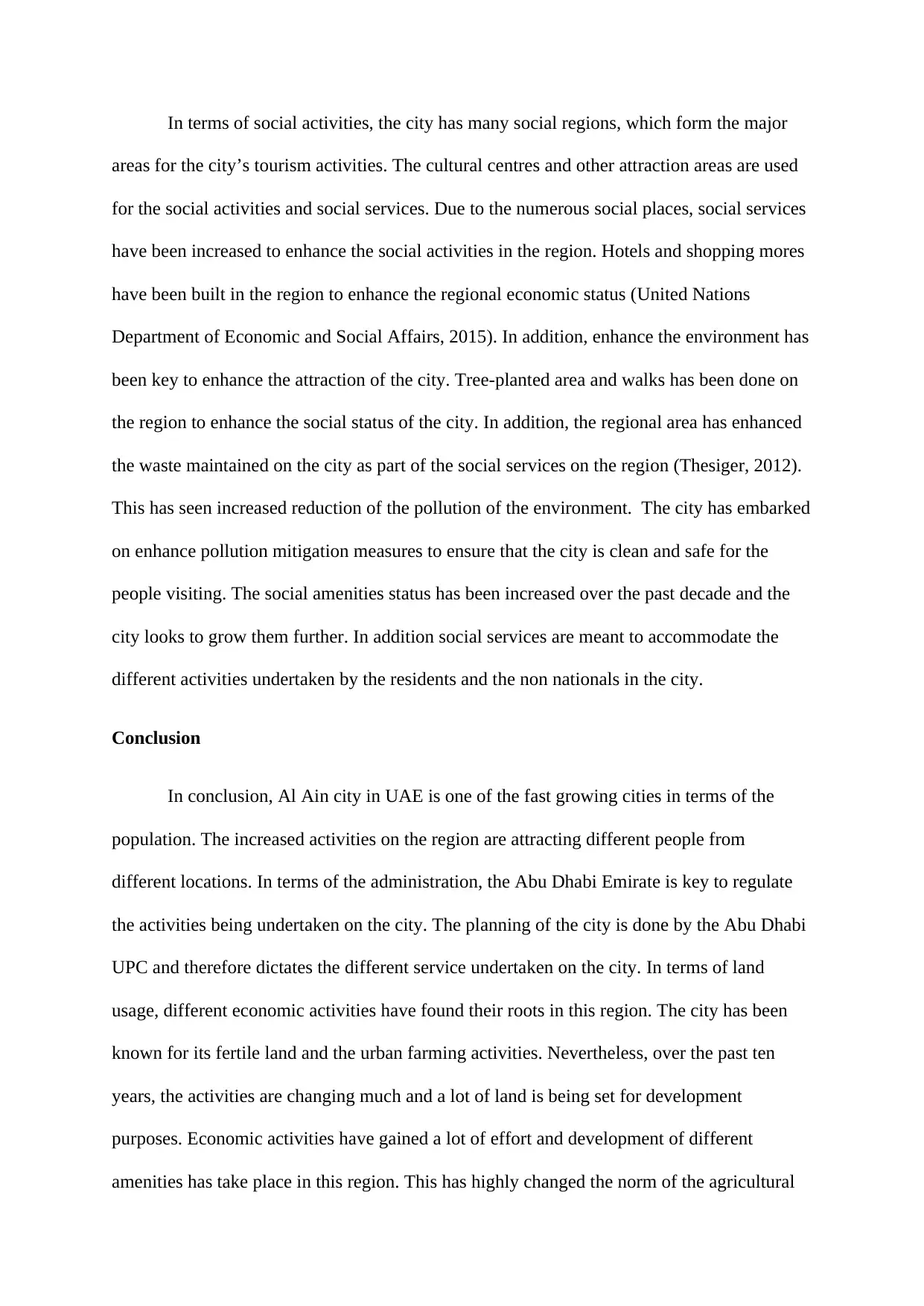
In terms of social activities, the city has many social regions, which form the major
areas for the city’s tourism activities. The cultural centres and other attraction areas are used
for the social activities and social services. Due to the numerous social places, social services
have been increased to enhance the social activities in the region. Hotels and shopping mores
have been built in the region to enhance the regional economic status (United Nations
Department of Economic and Social Affairs, 2015). In addition, enhance the environment has
been key to enhance the attraction of the city. Tree-planted area and walks has been done on
the region to enhance the social status of the city. In addition, the regional area has enhanced
the waste maintained on the city as part of the social services on the region (Thesiger, 2012).
This has seen increased reduction of the pollution of the environment. The city has embarked
on enhance pollution mitigation measures to ensure that the city is clean and safe for the
people visiting. The social amenities status has been increased over the past decade and the
city looks to grow them further. In addition social services are meant to accommodate the
different activities undertaken by the residents and the non nationals in the city.
Conclusion
In conclusion, Al Ain city in UAE is one of the fast growing cities in terms of the
population. The increased activities on the region are attracting different people from
different locations. In terms of the administration, the Abu Dhabi Emirate is key to regulate
the activities being undertaken on the city. The planning of the city is done by the Abu Dhabi
UPC and therefore dictates the different service undertaken on the city. In terms of land
usage, different economic activities have found their roots in this region. The city has been
known for its fertile land and the urban farming activities. Nevertheless, over the past ten
years, the activities are changing much and a lot of land is being set for development
purposes. Economic activities have gained a lot of effort and development of different
amenities has take place in this region. This has highly changed the norm of the agricultural
areas for the city’s tourism activities. The cultural centres and other attraction areas are used
for the social activities and social services. Due to the numerous social places, social services
have been increased to enhance the social activities in the region. Hotels and shopping mores
have been built in the region to enhance the regional economic status (United Nations
Department of Economic and Social Affairs, 2015). In addition, enhance the environment has
been key to enhance the attraction of the city. Tree-planted area and walks has been done on
the region to enhance the social status of the city. In addition, the regional area has enhanced
the waste maintained on the city as part of the social services on the region (Thesiger, 2012).
This has seen increased reduction of the pollution of the environment. The city has embarked
on enhance pollution mitigation measures to ensure that the city is clean and safe for the
people visiting. The social amenities status has been increased over the past decade and the
city looks to grow them further. In addition social services are meant to accommodate the
different activities undertaken by the residents and the non nationals in the city.
Conclusion
In conclusion, Al Ain city in UAE is one of the fast growing cities in terms of the
population. The increased activities on the region are attracting different people from
different locations. In terms of the administration, the Abu Dhabi Emirate is key to regulate
the activities being undertaken on the city. The planning of the city is done by the Abu Dhabi
UPC and therefore dictates the different service undertaken on the city. In terms of land
usage, different economic activities have found their roots in this region. The city has been
known for its fertile land and the urban farming activities. Nevertheless, over the past ten
years, the activities are changing much and a lot of land is being set for development
purposes. Economic activities have gained a lot of effort and development of different
amenities has take place in this region. This has highly changed the norm of the agricultural
⊘ This is a preview!⊘
Do you want full access?
Subscribe today to unlock all pages.

Trusted by 1+ million students worldwide
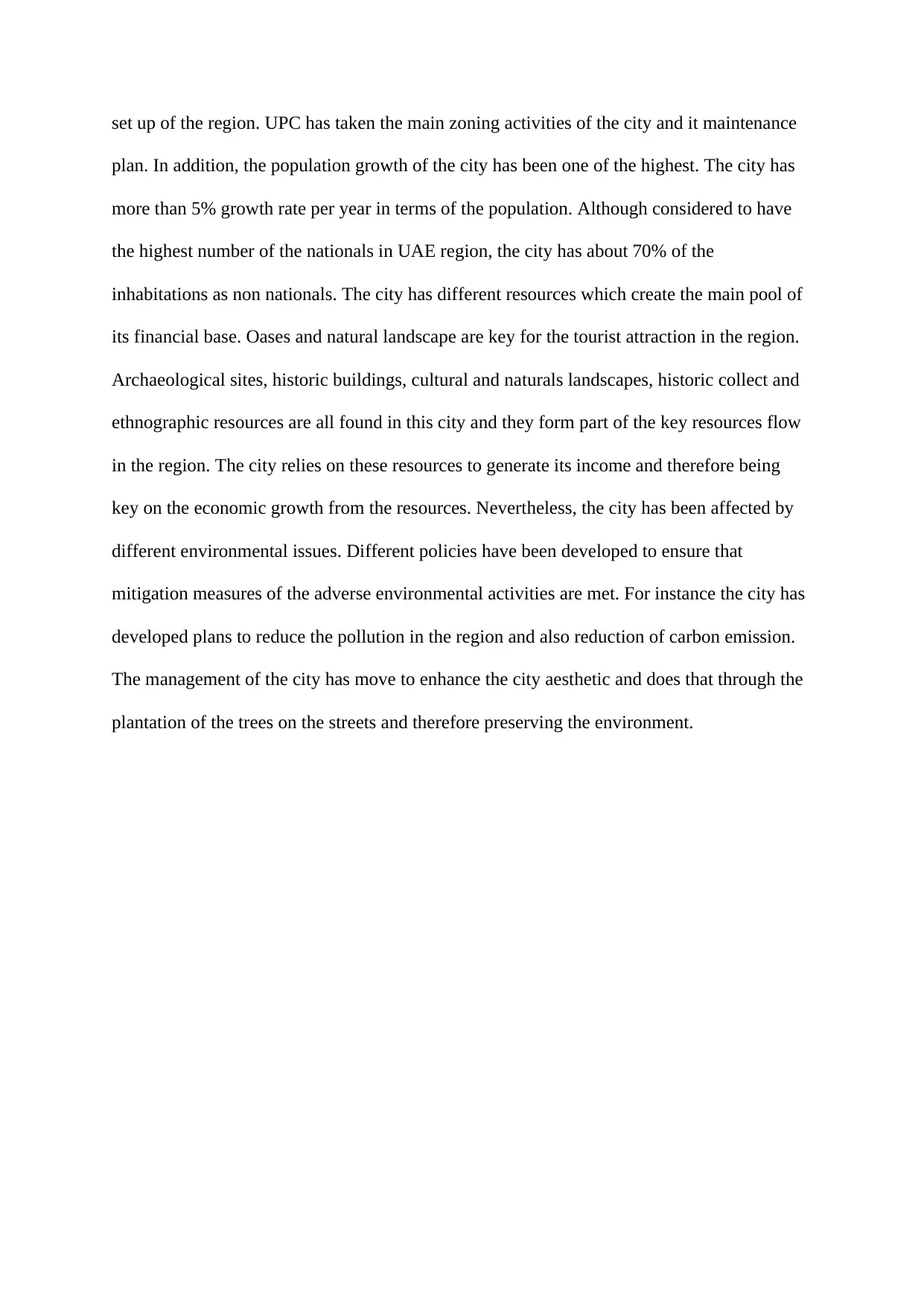
set up of the region. UPC has taken the main zoning activities of the city and it maintenance
plan. In addition, the population growth of the city has been one of the highest. The city has
more than 5% growth rate per year in terms of the population. Although considered to have
the highest number of the nationals in UAE region, the city has about 70% of the
inhabitations as non nationals. The city has different resources which create the main pool of
its financial base. Oases and natural landscape are key for the tourist attraction in the region.
Archaeological sites, historic buildings, cultural and naturals landscapes, historic collect and
ethnographic resources are all found in this city and they form part of the key resources flow
in the region. The city relies on these resources to generate its income and therefore being
key on the economic growth from the resources. Nevertheless, the city has been affected by
different environmental issues. Different policies have been developed to ensure that
mitigation measures of the adverse environmental activities are met. For instance the city has
developed plans to reduce the pollution in the region and also reduction of carbon emission.
The management of the city has move to enhance the city aesthetic and does that through the
plantation of the trees on the streets and therefore preserving the environment.
plan. In addition, the population growth of the city has been one of the highest. The city has
more than 5% growth rate per year in terms of the population. Although considered to have
the highest number of the nationals in UAE region, the city has about 70% of the
inhabitations as non nationals. The city has different resources which create the main pool of
its financial base. Oases and natural landscape are key for the tourist attraction in the region.
Archaeological sites, historic buildings, cultural and naturals landscapes, historic collect and
ethnographic resources are all found in this city and they form part of the key resources flow
in the region. The city relies on these resources to generate its income and therefore being
key on the economic growth from the resources. Nevertheless, the city has been affected by
different environmental issues. Different policies have been developed to ensure that
mitigation measures of the adverse environmental activities are met. For instance the city has
developed plans to reduce the pollution in the region and also reduction of carbon emission.
The management of the city has move to enhance the city aesthetic and does that through the
plantation of the trees on the streets and therefore preserving the environment.
Paraphrase This Document
Need a fresh take? Get an instant paraphrase of this document with our AI Paraphraser
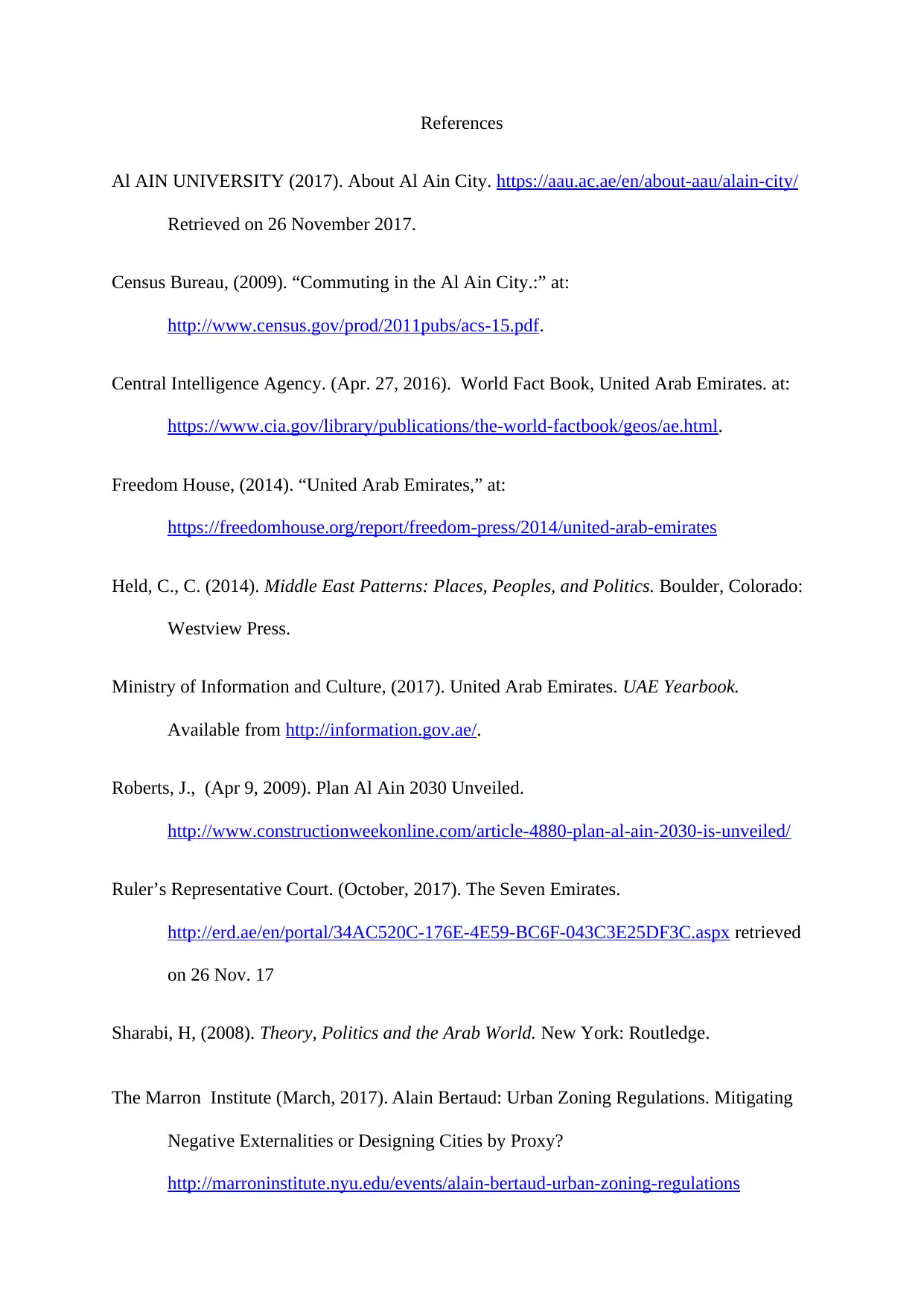
References
Al AIN UNIVERSITY (2017). About Al Ain City. https://aau.ac.ae/en/about-aau/alain-city/
Retrieved on 26 November 2017.
Census Bureau, (2009). “Commuting in the Al Ain City.:” at:
http://www.census.gov/prod/2011pubs/acs-15.pdf.
Central Intelligence Agency. (Apr. 27, 2016). World Fact Book, United Arab Emirates. at:
https://www.cia.gov/library/publications/the-world-factbook/geos/ae.html.
Freedom House, (2014). “United Arab Emirates,” at:
https://freedomhouse.org/report/freedom-press/2014/united-arab-emirates
Held, C., C. (2014). Middle East Patterns: Places, Peoples, and Politics. Boulder, Colorado:
Westview Press.
Ministry of Information and Culture, (2017). United Arab Emirates. UAE Yearbook.
Available from http://information.gov.ae/.
Roberts, J., (Apr 9, 2009). Plan Al Ain 2030 Unveiled.
http://www.constructionweekonline.com/article-4880-plan-al-ain-2030-is-unveiled/
Ruler’s Representative Court. (October, 2017). The Seven Emirates.
http://erd.ae/en/portal/34AC520C-176E-4E59-BC6F-043C3E25DF3C.aspx retrieved
on 26 Nov. 17
Sharabi, H, (2008). Theory, Politics and the Arab World. New York: Routledge.
The Marron Institute (March, 2017). Alain Bertaud: Urban Zoning Regulations. Mitigating
Negative Externalities or Designing Cities by Proxy?
http://marroninstitute.nyu.edu/events/alain-bertaud-urban-zoning-regulations
Al AIN UNIVERSITY (2017). About Al Ain City. https://aau.ac.ae/en/about-aau/alain-city/
Retrieved on 26 November 2017.
Census Bureau, (2009). “Commuting in the Al Ain City.:” at:
http://www.census.gov/prod/2011pubs/acs-15.pdf.
Central Intelligence Agency. (Apr. 27, 2016). World Fact Book, United Arab Emirates. at:
https://www.cia.gov/library/publications/the-world-factbook/geos/ae.html.
Freedom House, (2014). “United Arab Emirates,” at:
https://freedomhouse.org/report/freedom-press/2014/united-arab-emirates
Held, C., C. (2014). Middle East Patterns: Places, Peoples, and Politics. Boulder, Colorado:
Westview Press.
Ministry of Information and Culture, (2017). United Arab Emirates. UAE Yearbook.
Available from http://information.gov.ae/.
Roberts, J., (Apr 9, 2009). Plan Al Ain 2030 Unveiled.
http://www.constructionweekonline.com/article-4880-plan-al-ain-2030-is-unveiled/
Ruler’s Representative Court. (October, 2017). The Seven Emirates.
http://erd.ae/en/portal/34AC520C-176E-4E59-BC6F-043C3E25DF3C.aspx retrieved
on 26 Nov. 17
Sharabi, H, (2008). Theory, Politics and the Arab World. New York: Routledge.
The Marron Institute (March, 2017). Alain Bertaud: Urban Zoning Regulations. Mitigating
Negative Externalities or Designing Cities by Proxy?
http://marroninstitute.nyu.edu/events/alain-bertaud-urban-zoning-regulations
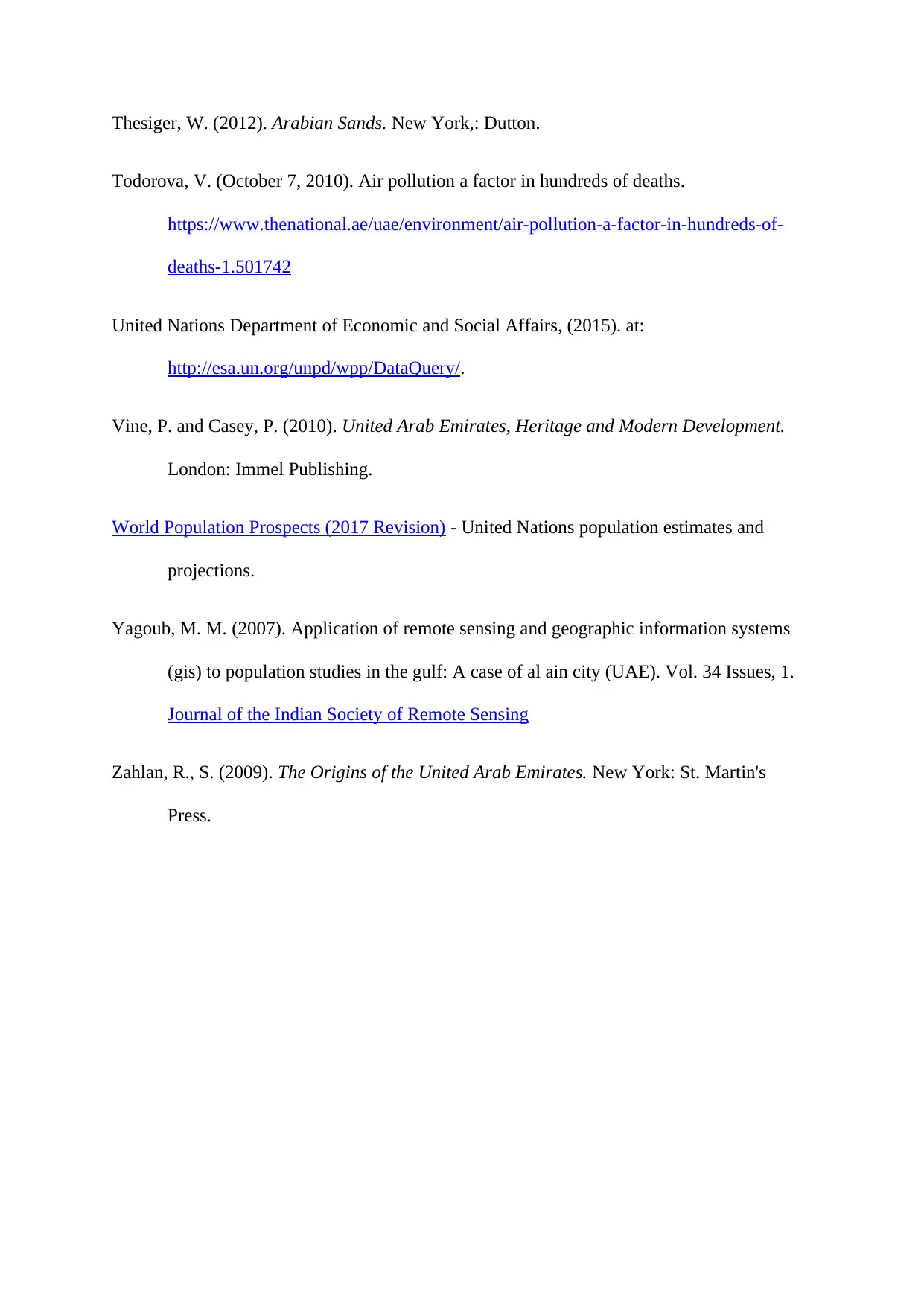
Thesiger, W. (2012). Arabian Sands. New York,: Dutton.
Todorova, V. (October 7, 2010). Air pollution a factor in hundreds of deaths.
https://www.thenational.ae/uae/environment/air-pollution-a-factor-in-hundreds-of-
deaths-1.501742
United Nations Department of Economic and Social Affairs, (2015). at:
http://esa.un.org/unpd/wpp/DataQuery/.
Vine, P. and Casey, P. (2010). United Arab Emirates, Heritage and Modern Development.
London: Immel Publishing.
World Population Prospects (2017 Revision) - United Nations population estimates and
projections.
Yagoub, M. M. (2007). Application of remote sensing and geographic information systems
(gis) to population studies in the gulf: A case of al ain city (UAE). Vol. 34 Issues, 1.
Journal of the Indian Society of Remote Sensing
Zahlan, R., S. (2009). The Origins of the United Arab Emirates. New York: St. Martin's
Press.
Todorova, V. (October 7, 2010). Air pollution a factor in hundreds of deaths.
https://www.thenational.ae/uae/environment/air-pollution-a-factor-in-hundreds-of-
deaths-1.501742
United Nations Department of Economic and Social Affairs, (2015). at:
http://esa.un.org/unpd/wpp/DataQuery/.
Vine, P. and Casey, P. (2010). United Arab Emirates, Heritage and Modern Development.
London: Immel Publishing.
World Population Prospects (2017 Revision) - United Nations population estimates and
projections.
Yagoub, M. M. (2007). Application of remote sensing and geographic information systems
(gis) to population studies in the gulf: A case of al ain city (UAE). Vol. 34 Issues, 1.
Journal of the Indian Society of Remote Sensing
Zahlan, R., S. (2009). The Origins of the United Arab Emirates. New York: St. Martin's
Press.
⊘ This is a preview!⊘
Do you want full access?
Subscribe today to unlock all pages.

Trusted by 1+ million students worldwide
1 out of 12
Your All-in-One AI-Powered Toolkit for Academic Success.
+13062052269
info@desklib.com
Available 24*7 on WhatsApp / Email
![[object Object]](/_next/static/media/star-bottom.7253800d.svg)
Unlock your academic potential
Copyright © 2020–2025 A2Z Services. All Rights Reserved. Developed and managed by ZUCOL.